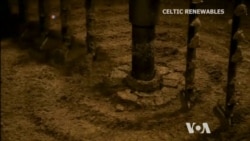Whisky has grown popular around the world in the last 10 years. New distilleries are opening, and old distilleries are trying to produce more whisky.
But as people make more whisky, they are also making more whisky waste – huge amounts of leftover grain and liquid.
Distillers do not have many options for what to do with this material. Some give it away to farms to feed animals.
Others pay over $300,000 per year to dispose of it.
And now, a company in Edinburgh, Scotland called Celtic Renewables is trying to make fuel with it.
What is draff anyway?
To understand whisky waste, you have to understand how whisky is made.
First, distillers take barley, corn or rye and turn the grain into mash. Then they combine the mixture with yeast. The yeast causes fermentation and creates alcohol.
Distillers heat the mash, create steam and then cool it down quickly. Alcohol vapor turns into liquid, ages, and eventually becomes whisky.
The used grain and water remain. In Scotland, the leftovers are called “draff” and “pot ale.”
Waste to biofuel
In 2015, Celtic Renewables received money from the Scottish government for their idea to turn draff and pot ale into fuel. The money has allowed the company to create a factory able to produce 500,000 liters of biofuel each year.
The company hopes to open the factory next year.
Martin Tangney is the president of Celtic Renewables. He thinks Scotland alone has enough raw materials from the whisky industry to produce 50 million liters of biofuel right away.
Tangney recently drove a car powered by his company’s fuel around a university in Scotland.
“It's quite fitting to use a Ford for this historic drive as the original Model-T Ford ran on biofuel, and the fermentation that we've developed to put the fuel in this car is a hundred years old, proven at large scale.”
The goal is not to replace gasoline completely. It is to reduce gasoline consumption and figure out what to do with the leftover material from distilling whisky.
Tangney said his product can make up to 15 percent of commercial gasoline without drivers having to modify their engines.
"The whisky industry will now have a sustainable and reliable way of disposing of their residue,” Tangney said. "Plus we’ll create a brand new industry out of something that has no value whatsoever."
I’m Dan Friedell.
Dan Friedell wrote this story for Learning English based on reporting by VOANews.com and Reuters. Kelly Jean Kelly was the editor.
Would you drive a car powered by biofuel made from grain? We want to know. Write to us in the Comments Section or on our Facebook page.
_______________________________________________________________
Words in This Story
distillery – n. a place where alcohol like whisky or vodka is produced
mash – n. a wet mixture of crushed malt or grain that is used in making alcoholic drinks (such as beer and whiskey)
yeast – n. a type of fungus that is used in making alcoholic drinks (such as beer and wine) and in baking to help make dough rise
fermentation – n. a chemical process that results in the production of alcohol
steam – n. the hot gas that is created when water is boiled
biofuel – n. fuel that can power vehicles or engines made from natural substances instead of oil
reliable – adj. able to be trusted to do or provide what is needed : able to be relied on
residue – n. a usually small amount of something that remains after a process has been completed or a thing has been removed








